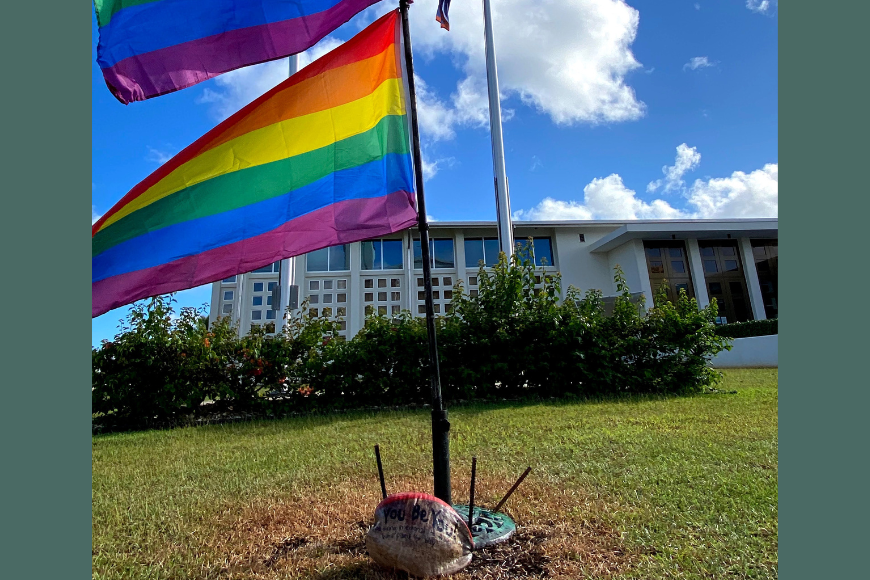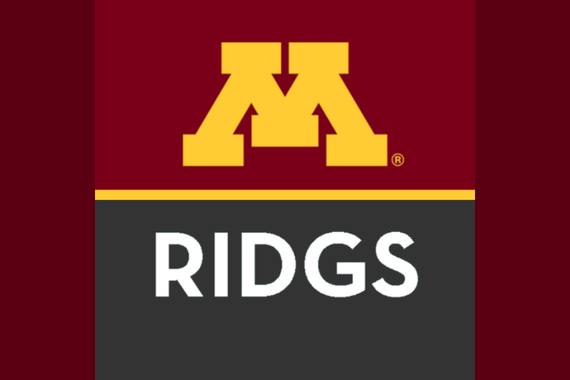History for Today
Jonny Quenga Borja (they/he/any pronouns) is a PhD candidate in the American studies department and recipient of a 2022 RIDGS Graduate Research Partnering Program (GRPP) Fellowship. Their dissertation is a shining example of community-engaged research, drawing from historical and anthropological methodologies in order to tell the stories, both past and present, of queer indigenous CHamoru people on the island of Guåhan (Guam in English). These stories take place under conditions of colonial silencing, and as such, involve complex permutations of CHamorus redefining, renaming, and reclaiming the intersections of their queer and Indigenous identities.
Background and Training
It was not predetermined that Jonny would study CHamoru culture, but rather the result of an evolution in their academic interests and a growing passion for understanding the margins of Guåhan’s history, culture, and society. They began their undergraduate career at Marquette University, where they studied speech-language pathology and social welfare and justice. A pivotal moment during that time was meeting with other scholars during a Ronald E. McNair Summer Program who helped them realize that Guåhan and the experiences they’d had there were the most important part of their life and that they wanted to spend their career studying and uplifting the experiences of other CHamoru people. In particular, English professor Jodi Melamed was instrumental in helping Jonny make that shift as smoothly as possible. Still, Jonny had to commit to making a hard disciplinary pivot from their previous work in health sciences to the humanities by choosing to pursue a PhD in the University of Minnesota’s American Studies program.
The impetus behind Jonny’s dissertation project is the near-complete absence of discourse centering queerness as an analytic and queer CHamoru (hi)stories and lives within Guåhan studies. However, Jonny is wary about wholly characterizing their work as identifying a “gap” in the narrative and filling it in. They see the rhetoric of “the gap,” so common to historical discussions, as having too innocent a connotation and obscuring the structural reasons for that absence, saying, “Honestly, I’m not interested in a gap. It is a gap, technically, but these stories and histories weren’t put down for a reason.” They do not write out of a traditionally neutral impulse to make sure that historical textbooks include a more complete narrative, since they are very aware that the stories of both Guåhan and queer people are usually relegated to the footnotes anyways. Rather, they write out of a more personal sense of duty to the population of CHamoru people who wish to see their stories told in a complete and respectful way, and also to the scholars of queer indigenous studies who will come after them. This personal motivation is heightened for Jonny by the fact that the current situation of queer CHamoru people is changing rapidly as a greater consciousness and acceptance of queerness and gender identity is spreading beyond just queer communities in Guåhan. Jonny’s work has the potential to enrich that discourse and provide historical context for where many commonly-held and often harmful beliefs about gender and sexuality in Guåhan come from.
Interdisciplinarity at Work
In order to find and write about evidence countering that silence, Jonny is using an interdisciplinary, two-pronged strategy of archival and ethnographic research. The archival research is, as is so often the case with histories of Indigenous people, a fraught endeavor since most written and preserved records pertaining to CHamoru history were created by colonizing agents such as naval governors and foreign anthropologists. For instance, Jonny was able to use the time gained by their RIDGS GRPP award to pull police records to see how many people in Guåhan were arrested for sodomy in the decades before it was legalized in 1978. Jonny’s co-advisor, American Indian studies associate professor Christine DeLisle, has provided invaluable training on how to rehistoricize these types of materials to make them valuable for this project. Most Guåhan historiography does not mention homosexuality; the first time Jonny read about homosexuality in Guåhan was in an ethnographic text from the 1930s by anthropologist Laura M. Thompson. Thompson claimed homosexuality was 'probable' given the skewed male-to-female ratios (there were more males than females) in the island, but did not provide further research. Jonny also looks at decrees issued by American Naval Governors from when the US occupied the island, who dictated that the indigenous societies should resemble normative American societies. One such decree put forth by Richard. P. Leary in 1899, prohibited family structures deemed “deplorable.” This included concubinage and rearing illegitimate children. Moreover, General Order No. 5 required unmarried individuals living together to acquire a marriage license so that the child or children “may become legitimatized.”
Jonny also began the process of oral history interviews with figures important to Guåhan’s queer community. Despite having a preexisting relationship with several interviewees, Jonny prepared with their co-advisor, American Studies Professor Martin Manalansan, to learn interviewing techniques that would not reproduce the exploitative and disrespectful research methods of other ethnographers who had studied CHamoru people. For Jonny, a large component of building trust and forming collaborative relationships with people included in the research involves spending a lot of time being immersed in the community, both physically and virtually, via the internet. Being of the queer CHamoru community themself helps Jonny build relationships and friendships, but also sometimes complicates those relationships when conflicts arise within the community. Within this balancing act, Jonny has also found a new appreciation for autoethnography, which they also studied with Dr. Manalansan. As Jonny has gotten so close to the subject matter of their writing, it has become very important to write their dissertation in a way that refelcts their own positionality as both a scholar and a member of the community. It is through this process that Jonny decided that the primary intended audiences of their work are their own academic and home communities, not academia as a whole.
Visual Aesthetics: A New Lens
One additional lens of analysis which Jonny began layering into their project is that of visual aesthetics. Since many queer CHamorus have been and still are artists, it has become clear to Jonny that they need to incorporate an analysis of art into their own work. As they put it, "art is a very expressive tool, and it’s perfect for finding the convergences and divergences, the trials and tribulations, the joys and the sorrows of the experience of being a queer CHamoru.” Working with art has also been the most joyful part of Jonny’s work, such as when they witnessed a performance by a queer CHamoru artist collective who designed costumes to represent a native species of bird that had been made extinct by the US military’s introduction of an invasive tree snake to the island. This was a multilayered performance that included elements of grief and anger at the erasure of something precious, and yet the artists looked beautiful and felt joy performing, which perfectly encapsulates a key aspect of the queer experience and the strength it gives to those who live it.


